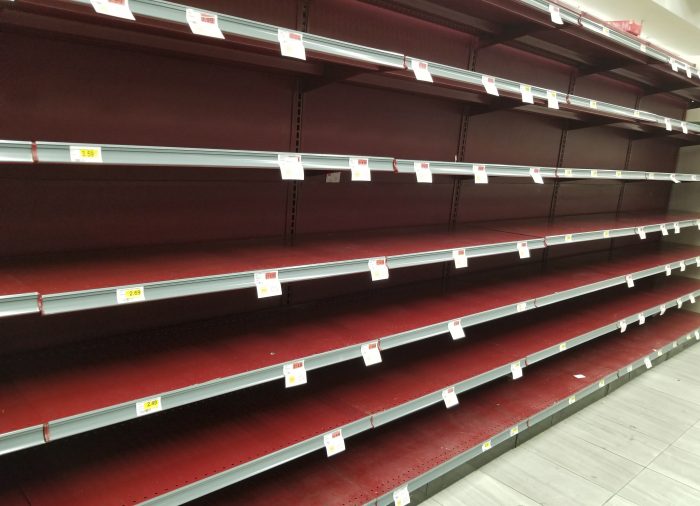COVID-19 and Retail Supply Chains: What Panic Buying Is Teaching Us

Are you running low on toilet paper? So is everyone.
Since the first coronavirus case was confirmed in the United States, “panic-buying” has hit grocery stores, convenience stores and pharmacies. Retailers are fighting to keep the shelves stocked and the doors open, all while keeping their employees safe.
Most grocery stores have shortened their operating hours to allow for sanitization.
Others have limited purchase quantities to avoid empty shelves and others have expanded the number of employees per shift. Stores have also enacted senior citizen shopping hours early in the morning to limit potential exposures for those at higher risk.
But what is it that these panic-buyers are so worried about? An extra bag of frozen vegetables won’t keep you from getting sick, and yet major stockouts are everywhere from the bread aisle to the butcher case.
The Consumer as Rational Decision Maker
One supply chain expert said assuming consumers aren’t crazy can help retailers understand the phenomenon of panic buying.
“One of the strategies that retailers can use [to combat panic buying] is to adapt to the reason that customers are buying more,” said Ananth Iyer, professor of supply chain management and senior associate dean, Krannert School of Management, Purdue University.
“Think of the consumer as the rational decision maker.”
As a rational decision maker, consumers panic buy for one of four reasons:
- They think prices will go up.
- They’re consuming more.
- They’re afraid they won’t be able to get to the store.
- They’re afraid the store will run out.
According to Iyer, the reasons behind the recent surge to grocery stores is a little bit of all of the above.
“Many stores have committed to not raising prices during times of crisis, so that initial worry has more or less gone away. As long as stores remain open, people realize they can still access things. Regarding stockouts, many stores are limiting the amount of purchases per item.”
Preparation Versus Improvisation

Ananth Iyer, professor of supply chain management and senior associate dean, Krannert School of Management, Purdue University
So what does this hasty trend mean for supply chains and how will it affect the future of retail?
Everyone has to eat, and grocery stores are typically where you find the cheapest and widest variety of food options. The industry’s intense competition and small margins work favorably for consumers in times of crisis.
“There are two ways to operate: being cost efficient and being responsive,” explained Iyer. “Historically, grocery store supply chains try to be very efficient.”
Unfortunately, the current environment retailers are forced to operate in is very responsive, which is a more expensive method of operation and can put the pinch on retailers.
On top of increased demand, stores are operating within shorter hours and most likely with more employees. With more cleaning responsibilities, the productivity of employees also goes down.
“You may need to do things to protect your employees,” Iyer said. “A lot of this means that whatever capacity of people you have, they can’t operate as efficiently, you have fewer operating hours and potentially higher input costs.”
Creativity Can Keep Costs Down
The balancing act for managing supply chains is being able to react to trend changes, fulfill increased demand, and then go back to being cost efficient without too many losses.
Humans are creatures of habit, and if they keep finding bare shelves at the store they usually shop at, they are going to find another go-to.
“From a customer perspective, the system is set up to satisfy them. From a store perspective, it’s about preventing stockouts and one option is to have a little more flexibility regarding how a particular category demand is going to be benefited,” said Iyer.
While no grocery store can exactly predict what consumers are going to buy more of one week and less of the next, there are strategies to keep the shelves full but not overflowing.
“If stores permitted a slightly broader selection of sources, then the odds of stockout decreases. The second option is to leverage the ability of the supply chain. That could be buying in bulk from the distributor; that’s a way to speed up delivery.”
A third option would be a larger emphasis on different delivery methods and online ordering. When inventory is ordered against what people purchase and prepay for online, it allows more time and insight for the retailer to schedule when things are coming in.
“The solution is getting people to realize that they still get what they want, they may not get it immediately. That strategy buys stores quite a bit of flexibility and time,” Iyer explained.
Robots Can’t Get Sick
The current climate in which supply chains are being managed is likely going to have a profound impact on the future of the retail industry, even after life goes back to normal.
Businesses are already thinking about what they can do to offset losses and avoid interruptions should something like this ever happen again. Some of these solutions include a greater focus on online ordering, the faster adoption of automation and leveraging third-party delivery services.
“Whoever is in the transportation industry, I would have them thinking about last-mile partnerships with third parties, which takes the pressure off the retailer,”said Iyer.
While we already see robots cleaning the floors in supermarket aisles, robots stocking the shelves have yet to be seen. Had they been there, these robots would likely have minimized the number of employees exposed to the risk of contracting COVID-19.
“[Coronavirus] might hasten the adoption of automated solutions in retail because those solutions are robust,” said Iyer.
While the adoption would result in unemployment for some grocery store workers, Iyer put it logically: “Robots don’t get viruses.” &










